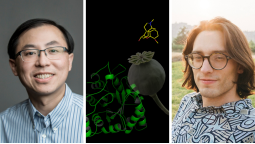Developing pain medication with fewer side effects

SASKATOON – Pain relief is a critical issue in medicine, but effective pain management is often overlooked. Opiates like morphine and codeine provide many patients with relief: from the ache felt after mild surgery to chronic pain experienced by cancer patients. However, this type of medication can cause multiple side effects and can lead to physical dependency with long-term use. Improving pain medication would help millions of people to have a better quality of life.
Dr. Ken Ng, a professor at the University of Windsor and adjunct professor at the University of Calgary (UCalgary), and Sam Carr, a PhD student from UCalgary, have been working with Dr. Peter Facchini’s group at UCalgary to better understand how natural opiates are produced. The team has narrowed their focus on one enzyme in the last stage of opiate assembly, a process that occurs naturally in the poppy plant.
“Imagine this sort of like an assembly line,” Carr said. “There are a lot of different steps in this specific pathway, and each enzyme contributes a different step from the starting product to the finished drug.”
Carr and Ng are looking at the enzyme responsible for the last step in the production of the drug codeine.
Using the CMCF beamline, located at the Canadian Light Source (CLS) at the University of Saskatchewan, Ng and Carr were able to image the structure of this unique enzyme.
The structural analysis gave the team ideas for how to modify the natural enzymes to ultimately create drugs that are more effective or have fewer side effects than natural opiates. This is part of Ng and Carr’s long-term program goals.
“If you could have this sort of understanding for many different enzymes, you could have a type of toolbox,” Carr said. “You could modify these drugs in a specific way to produce different versions that could possibly have different pharmaceutical properties.”
As Ng and Carr learn more about the structure and function of these enzymes, they can also transfer this knowledge to other natural drug syntheses, including enzymes that help produce anti-microbial drugs and other medicinal compounds.
“There is a really rich diversity of applications for these compounds,” Ng said. “This structure gives information, not just about opioid biosynthesis, but other natural products that include other classes of painkillers and medicinal applications like cancer treatment.”
The team’s protein crystallography research would not be possible without the use of synchrotron technology. “Due to the specific challenges with this particular project, I think it would have been impossible to solve this structure without a synchrotron,” Ng said.
-30-
The Canadian Light Source at the University of Saskatchewan is a national research facility, producing the brightest light in Canada—millions of times brighter than even the sun. One of the largest science projects in our country’s history, the CLS hosts annually more than 1,000 scientists from around the world who use our light to conduct ground-breaking health, agricultural, environmental and advanced materials research.
The Canada Foundation for Innovation, Natural Sciences and Engineering Research Council, National Research Council of Canada, Canadian Institutes of Health Research, the Government of Saskatchewan and the University of Saskatchewan fund our operations.
